Leila Marie Lawler's Blog, page 36
November 11, 2017
{bits & pieces} on a Monday
The weekly “little of this, little of that” feature here at Like Mother, Like Daughter! (This will all look and work better if you click on the actual post and do not remain on the main page.)

Well, I’m just squeaking in with this post on the wrong day! But I have a good excuse! Those of you who follow us on social media might have noticed that Sukie had her baby! She is doing very well after a quick birth. So I flew to Augusta to meet the little newest darling and lend a hand.
Welcome, Peter Edmund Saur! He is just as adorable as he can be! 8 lbs 12 oz, 21 inches, very sweet.
I do have some links for you – maybe today is a day off for you? Let’s read!
I personally find it very hard to assimilate straightforward historical narratives, done in textbook style. But start with a point of interest to me, something that I can visualize and care about, and work your way around the time periods from there, and then I can pay attention. The Shape of Rome is such a piece. Beginning with the news of the Mayor of Rome’s intention to remove one of the city’s main roads leading to its main historical venue, the Forum, Ada Palmer offers an appealing survey of the history of the city (focusing on one of my favorite churches, San Clemente). Be sure to read it to/with your older history student. It’s the layered quality of the city that is most important to grasp, and what the layers mean about not only what’s gone on there but what kind of people have left it so.
I enjoyed poking around Ada Palmer’s blog, Ex Urbe, and in the course of doing so, came across this link in a comment: The whole city of Florence can fit in one Atlanta cloverleaf. Rather devastating.
I visited the chapel where Fr. Emil Kapuan had been ordained when I was in Wichita a few years ago. I was incredibly moved to hear his story. Actually, any story I read about Fr. Kapuan reduces me to tears.
Right now the legitimacy of capital punishment is being debated amongst Catholic theologians. This response to a response actually has a good summary of the arguments and their foundations in logic and the authority of past teachings and, ultimately, Scripture.
The 3 Characteristics of an Educated Man.
From the archives:
Back when I was posting often, believe it or not, there was a fair amount of decorating and rehabbing going on here! Here’s the before and after of when we whitewashed the bricks in the kitchen. And even recently, we did redo the island. Part of me wants to design and build a house; part of me knows I will only ever slowly redo one part of an old house, bit by bit.
It’s almost not too soon to think about how exactly you will accomplish hosting Thanksgiving along with, possibly, nursing the baby and dealing with the barbarians darlings. I have an exact method for you: How to Prepare for Thanksgiving.
The next couple of weeks are chock full of saints’ feasts! A special shout out to St. Albert the Great (Wednesday), teacher of Thomas Aquinas, which tells you something about how “great” he really was! Anyway, as we come ever closer to Advent, it’s a good time to get really familiar with the calendar and see how the Church is leading us deeper with the holiness of the saints.
While you’re sharing our links with your friends, why not tell them about Like Mother, Like Daughter too!
We’d like to be clear that, when we direct you to a site via one of our links, we’re not necessarily endorsing the whole site, but rather just referring you to the individual post in question (unless we state otherwise).
Follow us:
Follow us on Twitter.
Like us on Facebook.
Auntie Leila’s Pinterest.
Rosie’s Pinterest.
Sukie’s Pinterest.
Deirdre’s Pinterest.
Habou’s Pinterest.
Bridget’s Pinterest.
Habou’s Blog: Corner Art Studio.
Auntie Leila’s Ravelry.
Auntie Leila’s Instagram.
Rosie’s Instagram.
Sukie’s Instagram.
Deirdre’s Instagram.
Bridget’s Instagram.
Habou’s Instagram.
The post {bits & pieces} on a Monday appeared first on Like Mother Like Daughter.
November 6, 2017
Michael Faraday: Read ~ and watch! ~ this, not that, about the scientific method!
Do you know this “eat this, not that” series of books? The idea is to help you make good choices in food and drink to avoid hidden calories that will tank your health. Well, Rosie had the thought that we could do something similar with books for the Library Project*.
The Chemical History of a Candle ~ Lectures by Michael Faraday
(This is not an affiliate or promotional post, other than, as usual, the Amazon links. I am simply passing along to you some exciting resources for your curriculum and enjoyment. Anyway, it can all be accessed for free!)
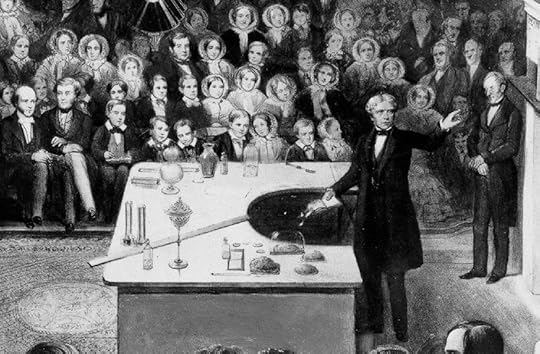
I will tell you a different, more effective and enjoyable, way to begin formal scientific study: by learning about how a candle works — but not only a candle! By studying the lectures of Michael Faraday, the child will learn about human respiration and about how one learns about and tests ideas in the world — the scientific method!
You could just pull out a dry textbook with the steps of each thing — burning candle, human respiration, scientific method — and drum each step into your child’s head. No doubt there will be boredom, tears, bitterness, recalcitrance, and in the end, either learning the material or… not learning it. There would definitely be no wonder and no joy. I think that nothing has hurt science more in our time than the way we teach it…
There is another way, before you get to that miserable workbook existence, which is to let things unfold by simply observing, along with a master teacher, seemingly ordinary processes that, with careful thought, will yield their mysteries… if we are patient.
How did I find out about this book? I’ll tell you if you don’t mind a long story…
God has given me what seems to be a unique ability (at least, I don’t see others being so silly) to stumble around with a strong opinion, trying to put it into practice in an unsatisfactory way, sometimes questioning whether in fact I am right, but not being super motivated to do things the normal way, and then only later, far later, discovering that someone has figured it all out much better and has definitely confirmed my bias.
I would say that this ability is a dubious one, but who am I to question Him. The upside is that I can write about it after the fact! The downside is… my poor children…
So it was that, having studied a lot of science in high school in the approved manner, I came to the homeschooling of my own children with a skepticism — a strong opinion, that is — as to the methods, philosophy, pedagogy, and, frankly, efficiency of the way science is taught.
I have recommended the writings of Arthur Robinson here before. Robinson is a world-class scientist whose homeschooled children have gone on to excel in science — and that is the sort of expert I like! Too often we are getting advice from sources that only repackage the mediocre methods of the conventional education system, slapping the “homeschool” label on it but not showing any results. Robinson rejects this process, and I’ll let you go ahead and read his reasons for yourself. To me they are convincing.
I actually emailed his foundation about 13 years ago to find out what he recommends as curriculum for the years before the child is ready to tackle college physics, chemistry, and biology (in that order, by the way — completely contrary to how it’s done in most high schools). The answer* amounted to having your child learn to be serious about observation and to do a lot of reading in the history of science, including the Faraday Lectures.
*At the end of the post I will let you know what Arnold Jagt, the man I corresponded with, shared about their book list.
I can’t say I did very well by my children on all this, true to form (see above, my “special gift”). I did try, but there’s only so much one person can do, I find, and you have to remember that for most of the time I was homeschooling, the internet was either not a thing or not as easily searchable as it is today!
But the Chief and I did read The Chemical History of a Candle — lectures by Michael Faraday, at the dinner table when our younger children were a bit older — specifically with our William, who early on showed that he really does have an interest in scientific matters. He was in middle school, Bridget was just a kid, and I think Deirdre sometimes took part (she would have been about 16 or 17).
It’s not an easy book to read in our day, although, gulp, it was delivered as lectures for young people (note their presence, along with that of many women, in the image at the top of the page!). The Victorian diction takes getting used to! We did our best, and I am proud to say that there was an actual candle lit, as is our custom at dinner, while we read and talked about the ideas.
Somehow I stumbled across this series of videos which I am sure will be of tremendous help to all. I can’t believe how lucky you all are to have them! So that is why I am writing this post — at last, this half-baked idea/execution of mine is in a form that others can actually use.
Here is the first video, and the others will pull up when you play it — all five of Faraday’s lectures:
This version has commentary from the producers:
You can buy companion volumes from these fellows, or of course you can buy on Amazon (again, my Amazon link is an affiliate link — a small amount of your purchase goes to me, thanks! — but I am not connected with engineerguy.com nor do I get anything for telling you about all this). You can also download the book and study guides for free by going to their site. I can definitely see the value of having hard copies, and they certainly deserve some support for all this content!
I recommend that you read the book yourself first. If your student is at least middle-school-aged, have him read it as well — let him wrestle with it a little bit! Then watch the video together. It may work just fine for the student to watch the video with commentary after that.
Look over the student guides and see how much of it, especially at the beginning, you can achieve just with ordinary discussion with your normal candle lit on the table! Candles are so beautiful.
A lot of the discussion arises just from looking at them. The more natural you can make the conversation, the better for the ultimate purpose of the whole thing, which is to be in the habit of musing on what we see — not pedantically reducing the moment to a series of tedious Q & As, just because that’s how they happen to be written out in the guide.
For instance, it’s fine to say something like “that flame has so many colors in it! I wonder how many we can actually identify!” and see what your child says about it, rather than asking the questions in the order and manner that they are listed. It’s so helpful to have the guide — I would use it as just that, a guide!
As you can see from the activities, some you could do with a very young child, like seeing how many drops of water you can get onto a penny. It’s good to know that a younger child would be interested to take part in this demonstration — and that at the very same time, one could also muse with John Henry Newman on capillary action and how it relates to other laws of nature (Discourse 3, The Idea of a University: Bearing of Theology on other Branches of Knowledge):
Again, did I know nothing about the movement of bodies, except what the theory of gravitation supplies, were I simply absorbed in that theory so as to make it measure all motion on earth and in the sky, I should indeed come to many right conclusions, I should hit off many important facts, ascertain many existing relations, and correct many popular errors: I should scout and ridicule with great success the old notion, that light bodies flew up and heavy bodies fell down; but I should go on with equal confidence to deny the phenomenon of capillary attraction. Here I should be wrong, but only because I carried out my science irrespectively of other sciences.
So there are many things to be learned, aren’t there — just by observing a candle!
This series could be a good chunk of your middle-school science year, in my opinion! See what you think!
*Here are some of the recommendations given to me from the Robinson Curriculum:
For very young children, the books of Arthur Scott Bailey, which you can upload to your Kindle and read aloud, or find secondhand. (I would avoid the paperback versions I see on Amazon that have dreadful fonts, like the Tale of Jolly Robin. Some of them are published by Dover Children’s Thrift Classics. I’m not sure how much of this sort of thing most children can take. Ambleside has more varied recommendations as well.)
The “Tom Swift and his — ” (Motorcycle, Motorboat, Airship, etc) books. (I gather that the basic idea is motivation to do lots of things with motors, rather than viewing them as black boxes for grownups.)
For older children, Common Sense of the Exact Sciences, by W. K. Clifford. (Maybe the engineering guys could do a video series on this one! Also the next one… ) Of the Motion of the Heart and Blood in Animals by William Harvey. (Harvey was immensely important to the study of medicine. Before his time, doctors relied on arguments from authority — if the ancients said it, that was good enough for them. No doubt the ancients were working on what they could observe, but one must keep observing! It’s not good enough to regard information as a closed book, and of course, Harvey was greatly aided by the development of lenses, however rudimentary. Studying him along with Faraday is important for understanding the scientific method, as well as for removing preconceptions about how modern that method is; Harvey was practicing medicine in the very early 1600s).
And here is a list of the Royal Institution Christmas Lectures of which Faraday’s were a part.
*What is the Like Mother, Like Daughter Library Project?
The post Michael Faraday: Read ~ and watch! ~ this, not that, about the scientific method! appeared first on Like Mother Like Daughter.
November 4, 2017
{bits & pieces}
The weekly “little of this, little of that” feature here at Like Mother, Like Daughter! (This will all look and work better if you click on the actual post and do not remain on the main page.)
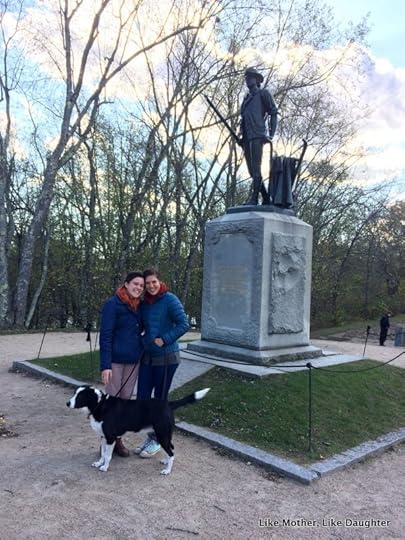
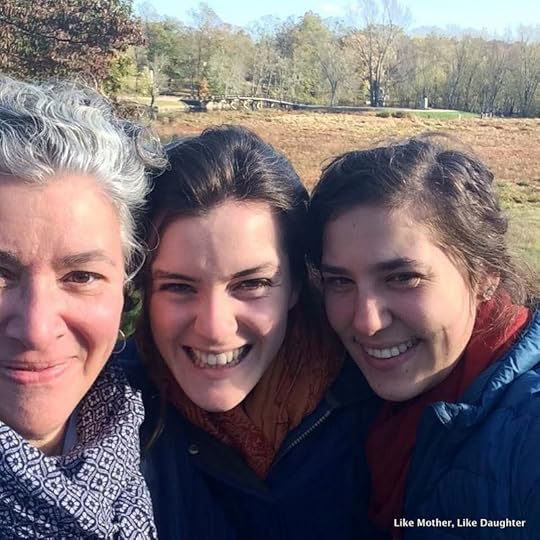
This past week was mostly taken up with Bridget’s break from school — having fun with her and her friend Maire, enjoying listening to them fiddle, enjoying the peace and quiet as they diligently studied, and getting together with friends and family.
When I think about this being her last year in college, my baby, I want to encourage all of you who are just starting out to persevere in encouraging your children to find their own path. Just forget about the world’s seeming confidence that it knows the exact formula for success. Now that all my children are grown, I see that it would have been impossible for us to have predicted how interesting and flourishing they all turned out to be, each in a way quite different from the others.
Each person is unique — we hear that all the time, don’t we! — and there is a lot of anxiety when you are first starting out — you can’t see where it is all going and you’re afraid of failing! It’s tempting to think that there is a certain process that you can rely on for success. I well understand that! But pursue what you love, let them pursue what they love, and make your home the center of your family’s life, along with the life of the Church. The years will unfold and reveal their delightful surprises!
The last night they were here, the girls played me my favorite tune, The Highlander’s Farewell — until Maire’s E-string broke! Here’s a little snippet!
This month, live along with the Church as she focuses our attention on the Holy Souls.

On to our links!
Some thoughts on how to use your space (even if you haven’t recently moved!): Before You Unpack.
Why You Hate Contemporary Architecture, is a great rant (warning, some language!), not only because it just comes out and says that things are ugly (and stunningly inappropriate — just look at the picture with the Tour Montparnasse!), but because it fails to articulate the solution, prompting, in my opinion, a deeper reflection on what beauty is, whether it is objective, and what we can do about getting it.
It’s not enough to say that we need more decoration or ornament, for instance; I think we could have a rant about Rococo architecture that would have us all secretly wishing we could just find a nice concrete bunker to enjoy (I jest, I hate concrete bunkers, but all that sugary overdoneness does get to be too much!). I am not convinced by the political left/right lens as applied in the piece. Nor can we be satisfied with this: “We should ask ourselves: why is it that we can’t build another Prague or Florence? Why can’t we build like the ancient mosques in Persia or the temples in India? Well, there’s no reason why we can’t.” Yes, there is a reason why we can’t — it’s because Prague and Florence have at their heart and were built around churches, by believers who weren’t afraid to sacrifice; it’s worship that gave these places culture. For that matter, even mosques and temples satisfied something in the human soul that somehow goes starving today, now that we’ve removed even a dim or flawed seeking for God from our environment. It’s so telling that the references in this parting plea are to sacred spaces and the cities that arose from them!
I have recommended lots of reading on this subject. There’s Roger Scruton, Stratford Caldecott, and David Clayton’s Way of Beauty (in which he explains how the pleasingness of, say, the Beacon Hill street mentioned in the article, comes from each element fitting not with the others except insofar as they each agree with an objective harmony — contrary to what the authors assert). In The Little Oratory, drawing on the writings of Jean Corbon and Scripture itself, we made the suggestion that when one prays with the Liturgy, beauty and transformation of the culture are the result. Anyway, as a rant, I found the article refreshing!
Edmund Burke’s observations and insights into free markets, by Samuel Gregg.
Joseph Pearce on Robert Southwell, poet and martyr. Perhaps his best known poem: The Burning Babe.
I’ve written a lot about the unique importance of the Liturgical Year — but really, you should just read this. Call it remote preparation for Advent!
The Swedish Art of Death Cleaning. (For the record, my Swedish friend had never heard of this, but if Konmari-ing things isn’t working — if, as another friend says, “apparently everything I own sparks joy, you can read the article and then move on to our very own Reasonably Clean House series!)
Jane Austen, Public Theologian.
A new site: The Liturgical Arts Journal — lots of beautiful information about the liturgy!
I guess we can all deplore what is happening out in the world, but how will it be in our families? Here are a couple of posts about that!
Standards and solidarity: Ten ways to give your child the gift of purity.
Dating Rules for Teenagers
Today is the feast of the great St. Charles Borromeo!
While you’re sharing our links with your friends, why not tell them about Like Mother, Like Daughter too!
We’d like to be clear that, when we direct you to a site via one of our links, we’re not necessarily endorsing the whole site, but rather just referring you to the individual post in question (unless we state otherwise).
Follow us:
Follow us on Twitter.
Like us on Facebook.
Auntie Leila’s Pinterest.
Rosie’s Pinterest.
Sukie’s Pinterest.
Deirdre’s Pinterest.
Habou’s Pinterest.
Bridget’s Pinterest.
Habou’s Blog: Corner Art Studio.
Auntie Leila’s Ravelry.
Auntie Leila’s Instagram.
Rosie’s Instagram.
Sukie’s Instagram.
Deirdre’s Instagram.
Bridget’s Instagram.
Habou’s Instagram.
The post {bits & pieces} appeared first on Like Mother Like Daughter.
October 28, 2017
{bits & pieces}
The weekly “little of this, little of that” feature here at Like Mother, Like Daughter! (This will all look and work better if you click on the actual post and do not remain on the main page.)

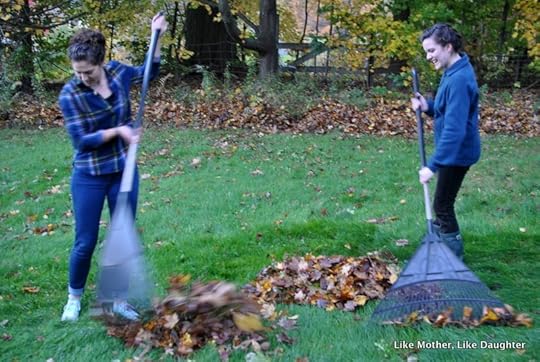

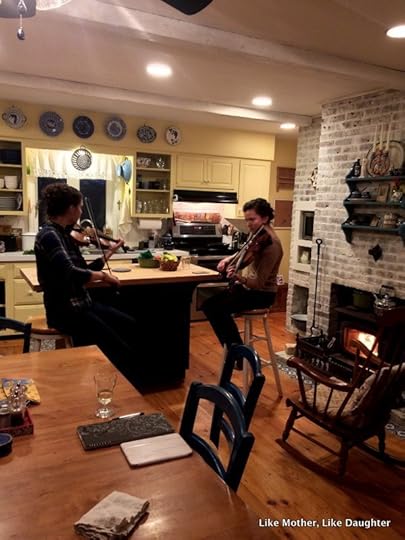
It’s Fall Break from college at last! So happy to have Bridget and her friend Maire home for a bit. It gets SO QUIET around here! And leaves just sit out there! That yard is not going to rake itself, you know! More kids, STAT!
(A few thoughts on music at home in the archive section below!)
On to our links:
Operating on baby before it’s born, by removing (and then replacing!) the entire uterus.
I love reading about people who just… see things and figure them out. I had never heard of Jane Jacobs or her insights into architecture and cities before reading this review.
Fr. Rutler: “The Saints Know the Music of the Heavenly Jerusalem.” Just a Rutlerian medley of musical thoughts… but it made me want to say that all the conversations about sacred music, even the ones about good sacred music (chant and polyphony as called for by Church documents), ends up being about how we feel — how the music makes us feel. But what about what is fitting for worship?
That old-time Rock and Roll might have given rise to today’s Rock, but it was qualitatively different and there’s a lot to enjoy in Rhythm & Blues, don’t you think? RIP Fats Domino.
Will you forgive me for posting yet another article about Richard Wilbur, whose passing on October 14 gave rise to reflections and appreciations? As James Matthew Wilson says, Wilbur’s “work immediately rewards the ear while also gratifying patient study.” (Warning: graphic and horrifying descriptions of what he saw in World War II.)
A long but good read from Samuel Gregg, now that for some inexplicable but nefarious reason the hive mind is trying to rehabilitate communism,: When Evil Triumphed.
Also a long read, from Mary Eberstadt, on The Primal Scream of Identity Politics, all of which to say what I try to say here: there is no substitute for the family. It’s something small and weak, but without devotion to the family, the forces of darkness overcome civilization. A priest friend says: “I found the connection she makes between the vagueness in knowing who counted as one’s relatives and outrage over “cultural appropriation” to be persuasive. Moreover, though it wasn’t her intent, it helps me better understand some of the Old Testament delight in genealogy: it provides so to speak the GPS coordinates that give the individual confidence to say “who I am” in virtue of knowing “where I am” in amongst the welter of humanity. What she says about “your mother’s boyfriend several boyfriends ago whom she hasn’t seen in years” being hard to view as your uncle brings it home pretty well.” Sounds like an argument for… good old traditional marriage…
From the archives:
Last week I said that I have trouble sometimes getting myself outside, and Monica wondered how I trick myself to do it. I wrote about it a bit in this post about gardening, just in case anyone is as motivation-challenged as I.
Self Control and Where to Get It.
A start on music in your family: I have some thoughts here: Folk songs and hymns… now that I’ve made all the mistakes and learned things almost too late, let me say: Sing! In harmony! Join a traditional choir or make your own. Get to know your local fiddlers; go ahead and start the children on violin, ukulele, tin whistle, or whatever they seem interested in. As they get bigger, piano, guitar, banjo (banjo is really clutch for an awesome folk sound). Most people aren’t going to be fabulous classical musicians, although it doesn’t hurt to try, of course; the main thing is to learn to make music together.
Today is the feast of two apostles, Simon and Jude! We are always for having an extra scoop of ice cream, but did you know that there are suggestions for special recipes on the pages we send you to for feast days? And activities too — not that you have to do anything, but sometimes it’s nice to know what the customs are or have been, seeing as we are so lacking in that department…
While you’re sharing our links with your friends, why not tell them about Like Mother, Like Daughter too!
We’d like to be clear that, when we direct you to a site via one of our links, we’re not necessarily endorsing the whole site, but rather just referring you to the individual post in question (unless we state otherwise).
Follow us:
Follow us on Twitter.
Like us on Facebook.
Auntie Leila’s Pinterest.
Rosie’s Pinterest.
Sukie’s Pinterest.
Deirdre’s Pinterest.
Habou’s Pinterest.
Bridget’s Pinterest.
Habou’s Blog: Corner Art Studio.
Auntie Leila’s Ravelry.
Auntie Leila’s Instagram.
Rosie’s Instagram.
Sukie’s Instagram.
Deirdre’s Instagram.
Bridget’s Instagram.
Habou’s Instagram.
The post {bits & pieces} appeared first on Like Mother Like Daughter.
October 21, 2017
{bits & pieces}
The weekly “little of this, little of that” feature here at Like Mother, Like Daughter!
Starting the fall cleanup, in a most desultory way, despite the glorious weather that judges anyone who isn’t outside from dawn to dusk! I don’t know what my issue is, but it’s not easy for me to get out there. I have to trick myself all sorts of ways…




I want to plant a cover crop, and I have the seeds all ready to go — that I bought last year, sigh. Maybe it’s too late now to plant, but I think I will anyway. It’s buckwheat and I think it will help my soil. So even though things are still sort of going along out there (we’ve only had one light frost!), I tried to do a little cleaning out to get ready.
I do have this issue with pulling out a plant that might still have some life left in it (which explains how my beds get so overcrowded — I just hate foregoing a plant, even though obviously it’s not going to thrive all stuck in together). But enough!
E. g. green tomatoes. I am as we speak processing 36 cups of chopped green tomato (into chutney and ketchup — the latter a first for me, so here’s hoping). But I can’t bear to pass over these stragglers I pulled out yesterday:
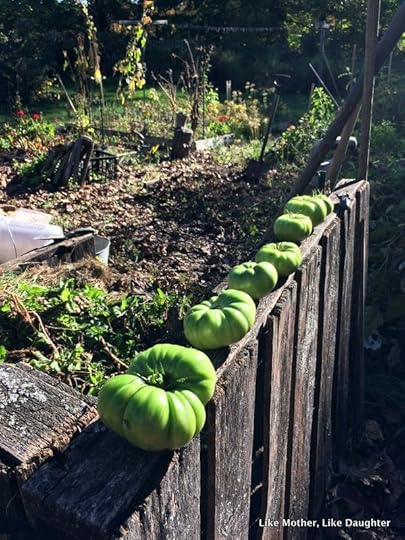
I mean, what if the reason we don’t make it through the winter is that we were seven green tomatoes short?!? I can read the headlines in the spring right now! “Family found not to have survived — pantry bare — compost forensics show rashly tossed apparently viable veggies from the fall!”
I know, we’ll have fried green tomatoes. Okay!
On to our links!
One good teacher. I encourage you to read this article! It’s more about appreciating the good people we meet in our lives who challenge us, and about being challenging to those we love, than about school or anything like that. But, I will say, in a good world, there would be schools with teachers like “Pop” Shaver. (The post also has great ideas for poems to get your children to memorize.)
Interesting game theory and medieval inside ball: Why the trial by ordeal was actually an effective test of guilt. Huge, if true!
Richard Wilbur, poet, died last week. May his memory be eternal! It’s worthwhile to recall this excellent essay about his life and writings, God’s patient stet. (Stet for those who don’t know is the proofreader’s mark conveying “let it stand”; most often, “actually, don’t delete.”)
It’s so terrible and narcissistic when people only talk about themselves! But… in this week’s mini-essay about friendship, John Cuddeback does a little examination of conscience.
As you know, I love C. S. Lewis’ Abolition of Man. A short essay (actually series of talks) that packs a huge wallop in terms of philosophical thought. Justin Dyer writes on The Abolition of Mad Men and the importance of “nursery-like belief in objective values,” or what I like to call “givens.”
The story of the conversion of Joy Lewis, C. S. Lewis’ wife, in her own words and with one of those fun doodles (if you are in your email, come to the site to see this video or click here) (the second part loads after the first):
Two weeks ago the Chief and I went to Hillsdale, MI to give talks. Mine were kindly recorded. If you are interested, here you go! I will also post them on my Speaking page (where you can also see what talks I give and ponder asking me to speak to your group!). These talks were for a ladies’ retreat, so they went a bit longer than usual. Actually, I have no idea how long I spoke and would probably prefer not to know, as I am sure it was way too long, oops, sorry! Such patient ladies!
The first talk was Praying in the Home, Saving the World:
http://likemotherlikedaughter.org/wp-content/uploads/2017/10/Leila-Lawler-Hillsdale-1017-Praying-in-the-Home-Saving-the-World.m4a
The second was on the Four Secrets to Destruction-Proofing Your Family. If that title triggers you, give a listen!
http://likemotherlikedaughter.org/wp-content/uploads/2017/10/Leila-Lawler-Hillsdale-1017-Four-Secrets-to-Destruction-Proofing-Your-Family.m4a
(In the essay above, on friendship, that I linked to, John Cuddeback charmingly resolves to do better in the listening department, especially with his wife. That is the sort of advice I give when I give this talk to men as well as women, but it didn’t make it in this time, as I was addressing only women! Well, there were two men, but about 80 women! So I went with that. Oh my gee, imagine how long the talk would have been… )
I have never posted audio files this way before. I think you could download and save for later listening by right-clicking? I hope you can listen at all!
Today we commemorate Sts. Ursula and Companions.
From the archives:
I suppose the weather will get cold at some point: How to dress your children when it does.
Getting the house ready for winter and staying warm.
Children bickering? Here are some strategies.
While you’re sharing our links with your friends, why not tell them about Like Mother, Like Daughter too!
We’d like to be clear that, when we direct you to a site via one of our links, we’re not necessarily endorsing the whole site, but rather just referring you to the individual post in question (unless we state otherwise).
Follow us:
Follow us on Twitter.
Like us on Facebook.
Auntie Leila’s Pinterest.
Rosie’s Pinterest.
Sukie’s Pinterest.
Deirdre’s Pinterest.
Habou’s Pinterest.
Bridget’s Pinterest.
Habou’s Blog: Corner Art Studio.
Auntie Leila’s Ravelry.
Auntie Leila’s Instagram.
Rosie’s Instagram.
Sukie’s Instagram.
Deirdre’s Instagram.
Bridget’s Instagram.
Habou’s Instagram.
The post {bits & pieces} appeared first on Like Mother Like Daughter.
October 14, 2017
{bits & pieces}
The weekly “little of this, little of that” feature here at Like Mother, Like Daughter!
Thursday, a couple of my friends decided that their children needed to have a lesson on bees and beekeeping from The Chief, as well as a nature drawing session with Habou. (They decided this before, but they came on Thursday.)
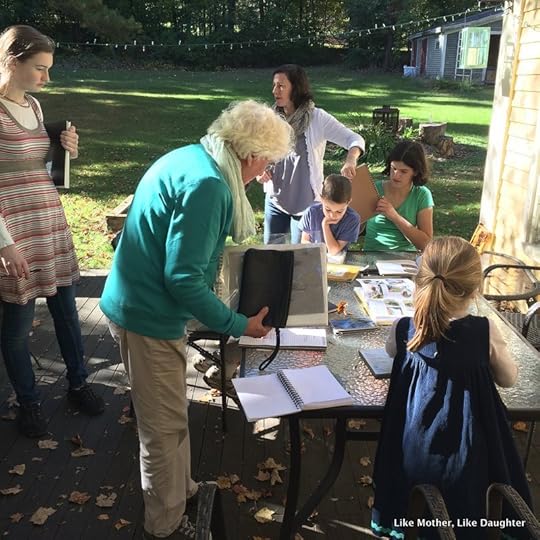
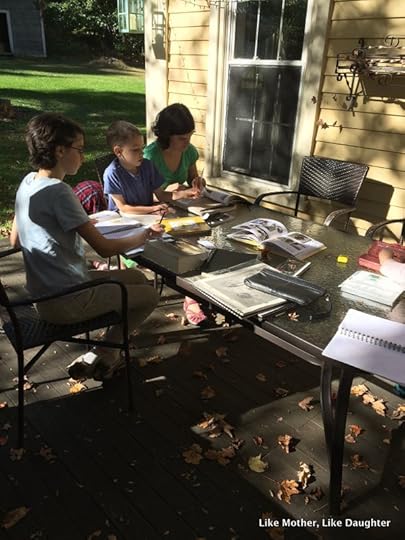
It was a glorious and slightly cool day, which meant the bees were so very calm! Such a win! We all got up close and enjoyed the spectacle of feeding the ones in the regular (Langstroth) hives, and examining the thriving top bar hive.
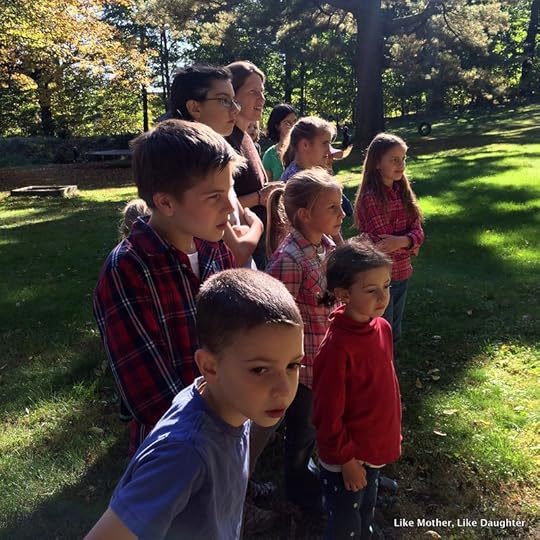
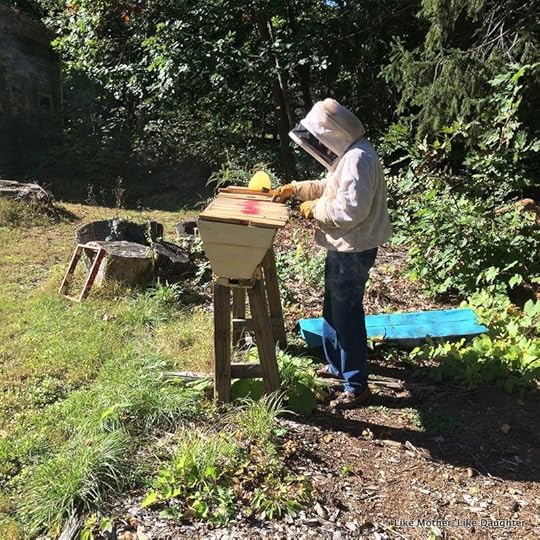
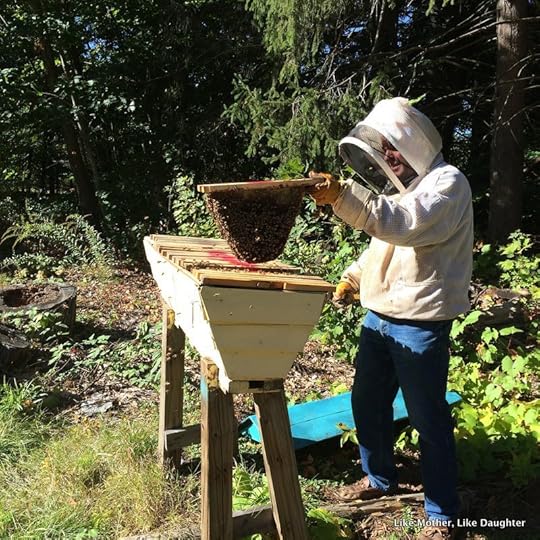
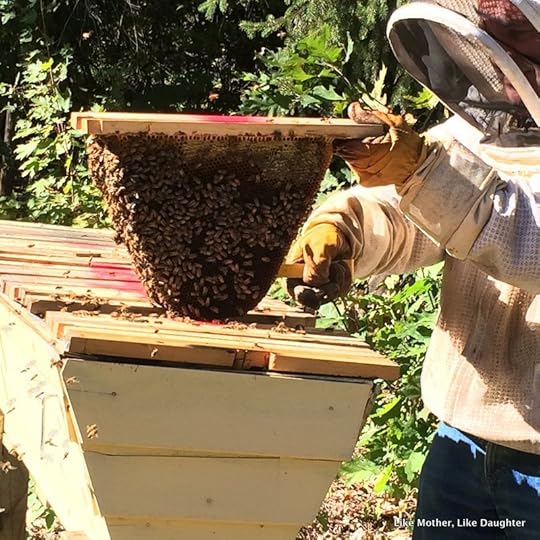
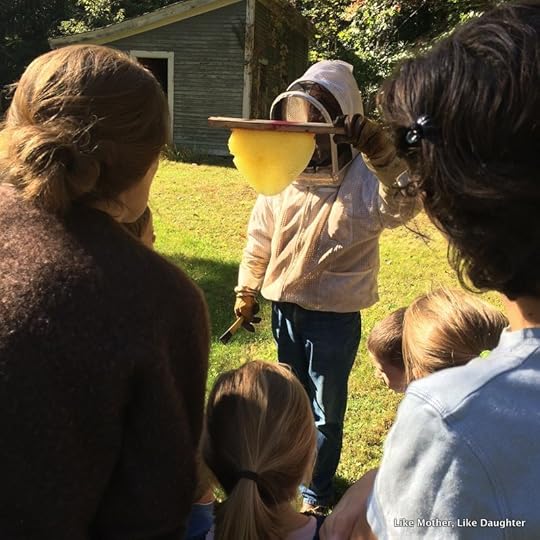
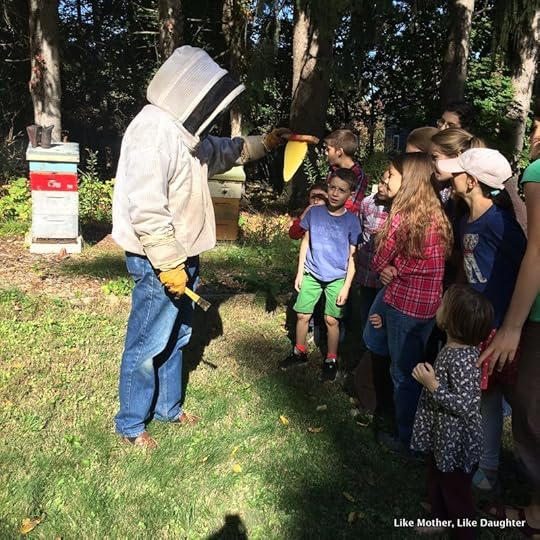
It would have been fairly possible to do all this without a bee suit, the bees were so calm — except that Phil is careful because he found out that he’s fairly highly allergic to bee stings! Yikes. In fact, he’s gotten stung and nothing bad has happened (since getting a series of shots), but might as well play it safe, right??
On to our links!
I was MIA last week — sorry! — because Phil and I were traveling in Michigan, visiting Hillsdale College and environs. We each gave talks there, and the lovely Sarah Schute interviewed us for a campus radio program. You can give a listen here (it’s not too long!). I hope to be able to post my talks soon!
Because I love the Anglican Ordinariate, I had to share this article on how it may fulfill the necessity for the “reform of the reform.”
An excellent review of John Senior and the Restoration of Realism from Russell Hittenger. Senior on the issue of teaching “Great Books” and the intellectual tradition in college: “I realized… that the scholastic philosophical system, so effective in refuting the rational skepticism of my generation, had had no impact on students whose minds were disconnected from tangible and emotional realities.” As I am fond of saying here, things must develop according to their natures. Senior is one of the very few educators to recognize and remedy the defect in education that ignores this fundamental principle.
A sweet essay on friendship: On Making Friends. A snippet: “The soul preaches humility to itself when it realizes, startled, that it has won a new friend. Knowing what a posset of contradictions we all are, it feels a symptom of shame at the thought that our friend knows all our frailties and yet thinks us worth affection.”
Puns generally emanate from our older (male) population; you could say they are a groan-up form of humor…*
At the end of the summer, Bridget had the amazing blessing of participating in the Thomas More College Oxford Program. One of the lectures was from Michael Ward, who readers know is a great favorite with us for bringing to light the organizing principle behind the Narnia stories as well as other writings of C. S. Lewis. His books Planet Narnia and The Narnia Code lucidly explain his theories, and his lectures are edifying as well, as Bridget reports! Here is a video series (all the videos are linked on this page) of interviews with Professor Ward — maybe your people will enjoy! (But — don’t inflict the theories on very young people; instead, teach them slowly how the ancients viewed the cosmos. Teach them all the richness of the arts of the pre-modern periods. Then let them winkle it all out for themselves! Eventually you can let them read Ward.)
A plea for chivalry to protect our maidens from dragon-culture, from Joseph Pearce.
The Dies Irae chant in musical history. I bet you didn’t know…
In case you missed it, here is the link to my interview with Marcus Grodi about my conversion. I know, I know, I sound way different from what you thought I’d sound like — I sound way different to myself! I was tickled by the still they captured here, with my hands up around my head, a gesture I think I actually make a lot:
Deirdre said, “the frame is delightfully reminiscent of my favorite moment from the movie “Clue.” I’m loving imagining that Mom is on an EWTN show just venting rage about her archnemesis.” “Flames, flames on the side of my face… “
Speaking of Deirdre, here’s what she will be doing in about 60 years: an obsessed decorating grandma up on a scaffolding somewhere!
*I’m pretty proud of this pun!!
From the archives:
Our favorite audiobooks!
You need books.
Me trying to tell you how to arrange furniture for family culture.
Today is the feast of St. Callistus I, Martyr.
While you’re sharing our links with your friends, why not tell them about Like Mother, Like Daughter too!
We’d like to be clear that, when we direct you to a site via one of our links, we’re not necessarily endorsing the whole site, but rather just referring you to the individual post in question (unless we state otherwise).
Follow us:
Follow us on Twitter.
Like us on Facebook.
Auntie Leila’s Pinterest.
Rosie’s Pinterest.
Sukie’s Pinterest.
Deirdre’s Pinterest.
Habou’s Pinterest.
Bridget’s Pinterest.
Habou’s Blog: Corner Art Studio.
Auntie Leila’s Ravelry.
Auntie Leila’s Instagram.
Rosie’s Instagram.
Sukie’s Instagram.
Deirdre’s Instagram.
Bridget’s Instagram.
Habou’s Instagram.
The post {bits & pieces} appeared first on Like Mother Like Daughter.
September 30, 2017
{bits & pieces}
The weekly “little of this, little of that” feature here at Like Mother, Like Daughter!
If you ever wondered how I became a Christian, I will be on The Journey Home, Monday evening, Oct. 2, at 8pm. Marcus Grodi and I discuss my conversion story, and I reveal that I can’t subtract very well — I say that I was baptized on October 23, 1977, thirty years ago, sigh… You are so right to get your homeschooling advice from me! I hope you enjoy the program — let me know what you think! You can watch on the Coming Home Network website where the show will be archived, or on EWTN.
We are enjoying a little visit with Bridget, home for the weekend!
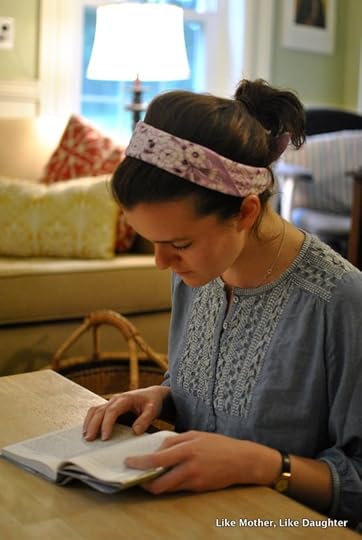
And the garden just keeps going, with a few beans, a cucumber or two, oodles of tomatoes, peppers, and eggplants, and just enough ground cherries to make me resolve to find them their own spot next year where they can really flourish! What is wrong with me! The usual… always trying to cram more plants into a small space. Also, not pictured, raspberries just all over the place.
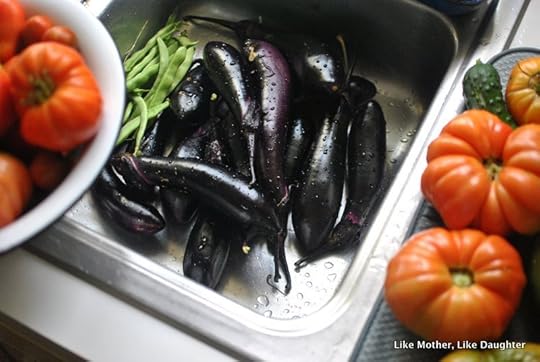

On to our links!
Bridget introduced me to Richard Wilbur’s Love Calls Us to the Things of This World. This is a stunning poem that you have to read a couple of times (well, I did) to perceive its depth. In this video below (if you don’t see it, you’re probably in your email or feed reader — come to our actual page online or go here), brought to my attention by a fellow Wilbur admirer, the author reads his own poem in his deep, thoughtful voice.
It’s under four minutes and include’s the poet’s commentary — and it will be well worth watching after you have read, enjoyed, and absorbed the poem, maybe discussing it with your high schooler. What I want you to be sure to get said high schooler to see is that perhaps — just perhaps — Wilbur himself doesn’t quite get his own poem! This can happen and actually does happen with a true work of art; the art takes on a life of its own that the artist isn’t completely in control of. Anyway, I find it interesting that he points out (very charmingly) that it doesn’t seem to detract from the poem that it starts rather abruptly. I should say not! Isn’t the very abruptness a way that the disorientation of the waking person is conveyed? It’s so true and exactly how it is when we awaken to life that doesn’t quite focus from its various levels; and in this case, the reality of the poem is the further disorientation of witnessing the two realms, earthly and heavenly, colliding, and trying to wake up while reconciling them.
Is Roald Dahl worth reading? Educator Sean Fitzpatrick examines the question. “His vile villains, his suspenseful plots, and his superhuman children can desensitize sensitive minds, but it is that danger which makes the young engage eagerly to face the thrill and challenge of a fun and funny world that is far from antiseptic. The question remains, is Dahl worth the risk?” (Auntie Leila says read some of his popular books yourself, if you didn’t as a child… and know your own children. Not everyone has to read everything.)
An amazing church with an amazing, miraculous story.
The mystery of the lost Roman herb. Long, weird, and interesting.
Images of everyday life in Victorian England.
Fun — a terrarium, a sealed, enclosed ecosystem, that has been going for 80 years with virtually no interference.
A long political theory read: Since I did post a piece a while back, Adrian Vermeule’s Liturgy of Liberalism, I thought I would post this essay from Sohrab Ahmari warning against abandoning that school of politics, written in response to Vermeule’s critique: The Terrible American Turn Toward Illiberalism.
From the archives:
I spoke in Cambridge Massachusetts last week about praying in the home and the importance of moral development for children (which necessarily entails commitment from parents! Everyone pursues virtue!) . I have a series on that — and a few years ago, I wrote this post: Men without chests, or, what C. S. Lewis made me think about.
By the way, the quote comes from The Abolition of Man (which I wrote about here). C. S. Lewis’ essay is a densely packed tour de force of philosophical explication, ultimately a prophetic warning against adopting Kantian values. The fabulous C. S. Lewis Doodle artist has illustrated the first chapter here (and provided a list of the literary and other allusions here — scroll down).
Today is the feast of St. Jerome — a consolation to all the irascible Christians out there! There is hope even if you’re not super nice! And tomorrow, superseded by the Sunday — St. Thérèse, whom we can certainly remember in our private devotions!
~~~~~~
While you’re sharing our links with your friends, why not tell them about Like Mother, Like Daughter too!
We’d like to be clear that, when we direct you to a site via one of our links, we’re not necessarily endorsing the whole site, but rather just referring you to the individual post in question (unless we state otherwise).
Follow us:
Follow us on Twitter.
Like us on Facebook.
Auntie Leila’s Pinterest.
Rosie’s Pinterest.
Sukie’s Pinterest.
Deirdre’s Pinterest.
Habou’s Pinterest.
Bridget’s Pinterest.
Habou’s Blog: Corner Art Studio.
Auntie Leila’s Ravelry.
Auntie Leila’s Instagram.
Rosie’s Instagram.
Sukie’s Instagram.
Deirdre’s Instagram.
Bridget’s Instagram.
Habou’s Instagram.
The post {bits & pieces} appeared first on Like Mother Like Daughter.
September 23, 2017
{bits & pieces}
The weekly “little of this, little of that” feature here at Like Mother, Like Daughter!
We had the honey harvest…

It’s a little more than 33 lbs (some not pictured), with about 7 more lbs of what I call “Cooked Honey” (you can see two of the darker jars in the back there) — that’s what I get after I boil down the stuff that’s mixed up with the comb wax and left in the buckets after jarring. I got some wax as well — not a lot, which is just fine, but some!
The adventure this time was that when Phil staged the frames in the vestibule — the section between the two front doors — some of them dripped quite the puddle of honey on the floor. Last week I wasn’t feeling too well; he kept muttering about what we would do to clean it all up, and I just could NOT cope. Besides, the frames were still out there (no longer dripping) — we had to move them before we did anything. That is, we had to start the spinning before dealing. And the weather had to dry out too.
This is the bad phone pic of the area I’m talking about, with the outside door open.
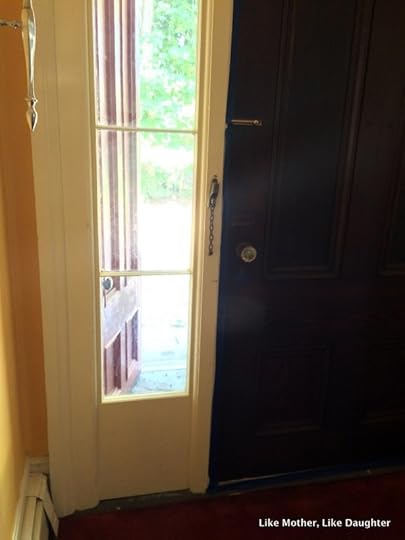
There’s nothing like really not wanting to do a job to motivate you to find the solution! I figured it out (possibly while talking to Rosie who also figured it out!): Just open the doors (and shut that inside door but tight) and let the bees clean it out!
Yes, there were some stunned bees lying about, but as of now, most of them either revived and flew away or were swept out by Himself. All the honey is gone! Not a drip left! It’s dry and — not sticky!! Phew! And gooood thing the honey didn’t spill inside the house!
On to our links!
Bridget, Thomas More College senior and likely provider of a good bit of the hospitality you will experience should you decide to attend, wants you to know about the upcoming Fall OPEN HOUSE at the College, October 8 and 9, Columbus Day weekend. Not only will you see New Hampshire in all its autumnal glory, but you and your upcoming college student will be able to get a good taste of life and merriment at this little, but mighty, school. Do sign up!
PSA: don’t cook kidney (or lima) beans in your slow cooker without boiling them and draining the water first. I first found out about the poisoning effect of improperly cooked kidney beans when Rosie posted about her bean tray that the kids played with — a reader cautioned about having kidney beans included, as one swallowed (not even chewed!) can cause death in a young child. I couldn’t believe it, but it’s a true fact. Luckily, Pippo was and is all about finding every last bean and disposing of it properly, or whatever else can be accomplished by paying attention. Usually I don’t go for this sort of thing, not being super alarmist, but gosh.
A lovely little post from John Cuddeback on friendship as Aristotle sees it.
Fr. Paul Mankowski, SJ, ponders the satirical and other talents of Evelyn Waugh, a man who was “all but incapable of writing a boring sentence.” I may or may not have previously linked to a talk he gave at the University of Chicago from which this (or many bits of this) essay derives, but it’s good enough to want a written version, anyway.
Conscience and Truth: an address not given by Cardinal Caffarra, alas, who died a few days before the conference he was to have attended.
At the end of the essay, the Cardinal (who was one of the signers of the Dubia put to Pope Francis on the subject of Amoris Laetitia), says, “Last but not least, there is an urgent need for a clear-cut proposal for a true Christian education of children and young people.” For the all-but-forgotten (except by moi!) teaching of Saint John Paul II, see Familiaris Consortio. This exhortation brings together Scripture and tradition on marriage and the family, explaining how the family is the original and irreplaceable “School of Virtue” as a “Domestic Church” that imparts teachings on truth, life, and love to its members in the context of love and mutual forgiveness. (It could be great to read the Cardinal’s address and the relevant portions of Familiaris Consortio — especially paragraphs 36-38 — in your St. Greg’s Pocket!) Could any program ever replace the family? No!
Are architecture and liturgy connected? I loved this article — so many amazing thoughts about how the art of architecture can express love — and worship — of God.
Another look at memorization, with a quote from Tolkien.
The New Liturgical Movement site is killing it with these articles — here’s another, that would make an amazing art class with your older children: A Baroque Confessional. A quote from the article that is definitely going on an index card over here:
“The true purpose of sacred art, as of good theology, is not to say something about God, but to be a medium through which the believer can participate in the realities signified by the work; ultimately, to insert us into the ongoing action of the Mystery of Christ.”
Two monks invent bestiaries — only sliiightly rude.
Nurturing Children: Why ‘Early Learning’ Does Not Help. The Neufeld Institute on socialization and other early childhood issues.
The art of Japanese samurai sword making, in case you need a 20-minute nap while the kids watch (if you are reading on your phone or a non-supporting browser, you may have to switch to something else to see what you think you are not seeing here):
Today in the Liturgical Year – Padre Pio! Great articles on the Catholic Culture site about this amazing saint.
From the archives:
I wish I could post more recipes! Maybe you remember this one: Frugal Baked Beans (we have at least one Kosher reader, dear Debbie, who loves this recipe — if you aren’t using ham, try a different smoked meat, like a smoked turkey leg).
Are you in full lunch-making mode over there? Here are my thoughts on how to streamline.
As mentioned, we just harvested the honey! This tutorial is from a couple of years ago — still how we do it, basically.
~We’d like to be clear that, when we direct you to a site via one of our links, we’re not necessarily endorsing the whole site, but rather just referring you to the individual post in question (unless we state otherwise).~
Follow us:
Follow us on Twitter.
Like us on Facebook.
Auntie Leila’s Pinterest.
Rosie’s Pinterest.
Sukie’s Pinterest.
Deirdre’s Pinterest.
Habou’s Pinterest.
Bridget’s Pinterest.
Habou’s Blog: Corner Art Studio.
Auntie Leila’s Ravelry.
Auntie Leila’s Instagram.
Rosie’s Instagram.
Sukie’s Instagram.
Deirdre’s Instagram.
Bridget’s Instagram.
Habou’s Instagram.
The post {bits & pieces} appeared first on Like Mother Like Daughter.
September 16, 2017
{bits & pieces} and this is Deirdre, signing off
The weekly “little of this, little of that” feature here at Like Mother, Like Daughter!
Connoisseurs of {bits & pieces} will have noticed that my contributions have been dwindling lately.
I have had to admit this fact to myself, as well.

Anyone else feeling the ramp-up from two kids to three? Phew. It’s been a full summer (oldest one turned 4) and we’re looking at a full fall as well. As 1 out of every 6 people in the grocery store (or other public place in which I’m juggling) likes to remind me, “I have my hands full.”
Yes, full of blessings! (A helpful response I learned from my friend Valerie.)
[Pause to appreciate the cool, funky pear from Habibti’s pear tree!]
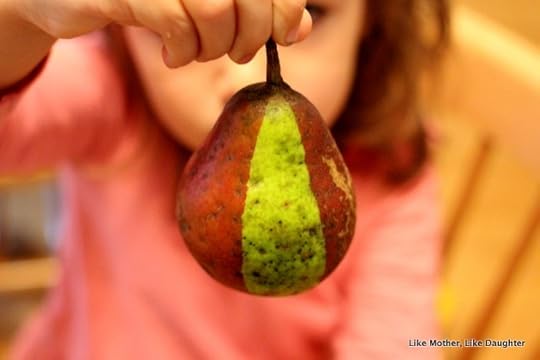
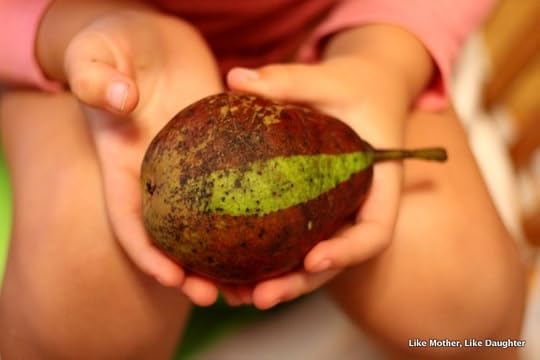
And of course there is down time, and we all can make time for the things we love. And I do love to get on here to contribute and I’ve loved doing {b&p}. But the truth is that this feature, which was originally my idea, has gotten to be a bit too much, on top of the other things I’m finding time for (over at daedalshop). The links haven’t been originating from my reading for quite some time now! I have time for books right now (while nursing) but not for online articles, it seems.
[Pause to appreciate the pretty things I won by rummaging through my neighbor’s recycling. Casually took a break in my rummaging to talk about traffic issues with a candidate for local politics as he was going door-to-door… then recommenced rummaging. I’m classy like that.]




[Pause to appreciate the buttermilk chocolate cake I made for Finnabee’s aforementioned birthday at the height of berry season. I made a ganache with sour cream – because I had no heavy cream – and absolutely loved it with this cake!]

All of which is to say that I will no longer be keeping up the routine pretending to keep up the routine of {bits & pieces}. Instead, I will try to check in every once and a while when I have a full-on post in me! Thanks for your understanding!
This week’s links! (Once again, brought to you by my mom!)
On hurricanes:
Some businesses are just better than others. H-E-B is one of those: The inside story of what it took to keep a Texas grocery chain running in the chaos of Hurricane Harvey.
Waffle House is another. “The Federal Emergency Management Agency even measures the severity of a storm’s damage by something called the Waffle House Index. When a Waffle House restaurant shuts down, it’s really bad.”
Okay, maybe we all just want to stop thinking about the hurricane(s), but one more: Walker Percy’s theory of Hurricanes. (The Chief and I really like his work, especially this one, which remains true and kind of prophetic: Lost in the Cosmos.)
Longer reads:
A readable explanation of subsidiarity, the principle in Catholic social teaching that orders justice. It’s a bit tricky to explain; I thought Stephen M. Krason did a good job here. His conclusions might be a bit shocking if all you ever hear is a secular, government-oriented way of thinking.
Cardinal Sarah’s address to Fifth Roman Colloquium on Summorum Pontificum: “‘Forgetting about God is the most imminent danger of our age’, Cardinal Ratzinger warned…’As against this, the liturgy should be setting up a sign of God’s presence,’ the Cardinal continued. There can be no doubt that the tangible sacrality of the usus antiquior of the Roman rite serves do this very well today, most particularly in its sung and solemn celebration. Additionally, its disciplined silent sacrality also serves to remind us that in every liturgical celebration of whatever use ‘the primacy of God should be kept in view first and foremost.'”
Archeological news:
Amazing artifacts: lost secrets of first Roman soldiers to fight the barbarians found — including swords and scabbards!
Bones of St. Peter found in 1000-year-old church.
Randomly:
The title is a bit click-bait-y — but the article recounts the unique personality of Alice Thomas Ellis.
A little affirmation if you are stepping out of the mainstream, academically, from Anthony Esolen.
We have always loved Hillaire Belloc’s Cautionary Tales — this article says they are inexplicably popular, and then goes on to explain.
For fun:
Cute article about Dolly Parton. We can’t help it.
Wow: Resurrecting the Incredible Flower Crowns of Old Ukrainian Wedding Photos
From the archives: Interested in learning more about the Liturgy? Don’t forget that we have readings of two important works on the subject: The Spirit of the Liturgy by Romano Guardini and The Spirit of the Liturgy by Joseph Ratzinger (Pope Benedict XVI). You will be guided as you read by moi, and you will understand much better what Cardinal Sarah is getting at in the speech, above. These book clubs would make excellent reading this Fall for your St. Gregory Pocket!
Today is the feast of Sts. Cyprian and Cornelius, Martyrs. Tomorrow, the Sunday supersedes the feast of Hildegard von Bingen, Doctor of the Church, but I’m sure she’ll pray for us anyway!
~We’d like to be clear that, when we direct you to a site via one of our links, we’re not necessarily endorsing the whole site, but rather just referring you to the individual post in question (unless we state otherwise).~
Follow us:
Follow us on Twitter.
Like us on Facebook.
Auntie Leila’s Pinterest.
Rosie’s Pinterest.
Sukie’s Pinterest.
Deirdre’s Pinterest.
Habou’s Pinterest.
Bridget’s Pinterest.
Habou’s Blog: Corner Art Studio.
Auntie Leila’s Ravelry.
Auntie Leila’s Instagram.
Rosie’s Instagram.
Sukie’s Instagram.
Deirdre’s Instagram.
Bridget’s Instagram.
Habou’s Instagram.
The post {bits & pieces} and this is Deirdre, signing off appeared first on Like Mother Like Daughter.
September 13, 2017
Our favorite audiobooks!
In our last episode, I had some thoughts to encourage you with reading aloud to the children — just some little tips to make it more enjoyable and comfortable for everyone. I promised some favorite audiobook suggestions from all of us over here (and you’ve already chimed in with some of yours on that post — we’d love to hear more!), so this is that! All our recommendations below!
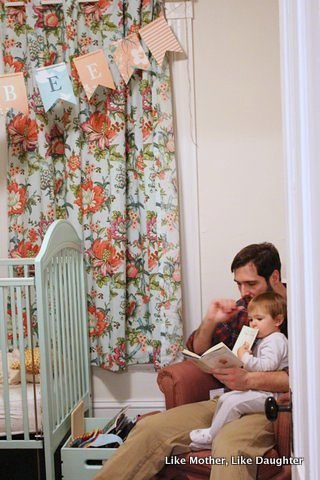
But — let me just reiterate what I said in the comments before: don’t let the professionalism of audiobooks deter you from reading aloud to your children. They love you! Reading to them is so different from listening to a recording. Each has its own merits, but when you read aloud to your children, you have the chance to stop and talk about things, to laugh and enjoy and savor something you really love, to reread a particularly relished section, to shed a tear together. Bridget and I practically sobbed through the ending of C. S. Lewis’ The Last Battle, just the two of us on the sofa; for both of us the vision of heaven was so beautiful and moving, and for me, I was conscious that this would be the last time I’d read it to one of my children, making the tears extra bitter-sweet.
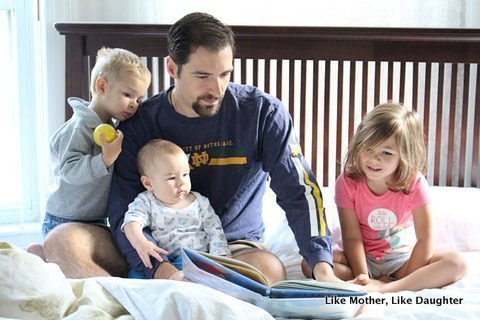
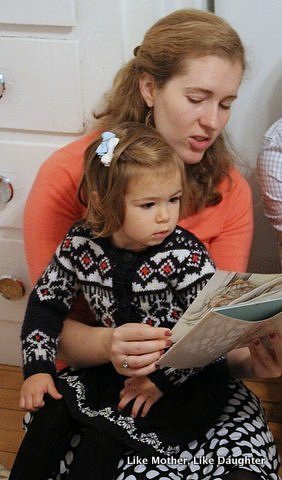
Relaxing on the couch with each other means so much, you know?
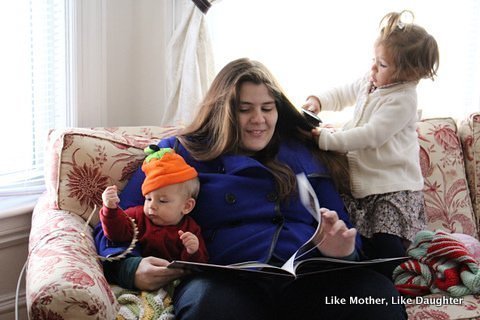
(I really got a kick out of this pic of Deirdre’s kiddos with their young Auntie!! What a good sport she is!! Sitting down to read with them before she even gets her coat off!)
Do you have that one child who rarely lets you give him a hug? Do you know that you have to work on making sure you physically touch your children more? In this rushed, busy, hectic life of ours, we need a good excuse to build cuddles into our lives. Reading together is that. And more. So don’t give it up!
All that said, we might as well listen to something good in the car! So, without further ado, here is a list of our favorites — and that means that we love the narrator. As always, the links to Amazon are affiliate links, meaning we get a little something when you buy — and if you sign up for Prime using our links, we get a nice little bonus, so thank you! If you buy or already have a book on Kindle, often the whispersync version (which allows you to go seamlessly from reading to listening and back again) is not much of an add-on. And while some of the selections are pricey, they are not bad if you have a subscription to Audible.*
(For me, anything narrated by Martin Jarvis is so worth it. The man can channel any number of voices and sustain them for however long it takes, making Dickens a veritable feast for the ears. His readings are also highly intelligent; he gets the nuances of the sometimes intricate language, and conveys them.)
For Littles:
The Tale of Peter Rabbit, by Beatrix Potter When I was little, I had a (vinyl) record of this whimsical and adorable tale, narrated by Vivien Leigh. Somehow when I had children of my own, I found a copy in a record store! I really did shed tears when I heard it again, with its fun and bittersweet songs. For some reason, no one has put it on CD, but you can buy just the one story at least. On YouTube they have the others, but the Peter Rabbit is the best.
A Bear Called Paddington, by Michael Bond, read by Stephen Fry
Frog and Toad, by Arnold Lobel Suki says: although Bridget didn’t like it, which makes me question everything! It’s read by the author! The kids and I like it!
Little Bear books, by Else Holmelund Minarik
Curious George, by Margaret and H. A. Rey plus others in the series.
Little House in the Big Woods, by Laura Ingalls Wilder — includes Pa’s fiddle!
Henry Huggins by Beverly Cleary – Neil Patrick Harris
Beezus and Henry by Beverly Cleary – William Roberts
Vivaldi’s Ring of Mystery – As Deirdre says: “It will never get old. I say that having grown up on it myself and now listening to it at a rate that would make me want to smash and burn a lesser recording — but I still love it to pieces.” NB: Not many available, but I include the link so you can see it (older versions have a different cover) and possibly recognize and snatch it up at a book/CD sale!! By the same company, we aren’t excited about the Mozart one but Mr. Bach Comes to Call is nice — not as stellar as the Vivaldi but fine.
Winnie the Pooh, by A. A. Milne – Deirdre prefers this Jim Broadbent narration to the others, even the Stephen Fry one.
Great and Good books for older children and adults:
David Copperfield, by Charles Dickens
Hard Times, by Charles Dickens
Cranford, by Elizabeth Gaskell
The Canterbury Tales, by Chaucer This one is narrated by Jarvis and others; if you go to the listing on Audible and look at the reviews, you will find a very helpful one in which the reviewer has offered a helpful “index” in the form of times at which to find each Tale.
Orgueil et préjugés, by Jane Austen Have someone learning French? How about Pride and Prejudice in French! My thinking is that if you already know a work backwards and forwards, listening to it in another language helps with facility. Great narration by Évelyne Lecucq. The translation has come under criticism from some reviewers on Amazon, but it sounded fine to me.
The Abolition of Man & The Great Divorce, by C. S. Lewis The former work must be read carefully and absorbed slowly. But hearing it can be a good supplement!
Uneasy Money, by P. G. Wodehouse I also like Simon Vance’s narration (he did the one above as well). His relaxed voice is easy to listen to!
Dombey and Son, by Charles Dickens Different narrator, not Jarvis — pretty good!
Sir Gawain and the Green Knight For the advanced student who really wants to hear the Middle English.
Father Sergius & Other Short Stories, by Tolstoy
Lord of the Rings, by J. R. R. Tolkien This recording comes highly recommended; I’ve listened to a snippet and it certainly sounds amazing, but full disclosure, we haven’t heard the whole thing. Maybe they have it at the library?
Bonus: A couple of fun reads for you:
What Alice Forgot, by Liane Moriarty (Edited to add: I love the narrator of this book — her accent is perfect for the Australian setting. I will say that it’s a book that is only for adults. It’s a delightful read that makes you look at life differently, and overall the message is a good, even excellent, one, well delivered. However, there are moral issues that are dealt with in a less than upright way — IVF is taken for granted as a good thing, and even abortion is passed over lightly. In a lesser story these things would be dealbreakers; in this story I think the mature person has enough to consider, and the main message is cleverly enough delivered, that it’s worth simply having one’s own mental reservations and moving on. I don’t think a teen should be subjected to that, though.)
One Hundred and One Dalmatians, by Dodie Smith Another Martin Jarvis!

*It took me a while to wrap my mind around how Audible works. You can get a subscription and then use your credits wisely to get the more expensive audiobooks. But you don’t have to subscribe! You can buy (less expensive) ones without a subscription. You can certainly subscribe for a month or two and then quit — whatever you have bought stays bought and in your library. You just need to use your credits before you quit.
The photos are all by Deirdre!
The post Our favorite audiobooks! appeared first on Like Mother Like Daughter.



